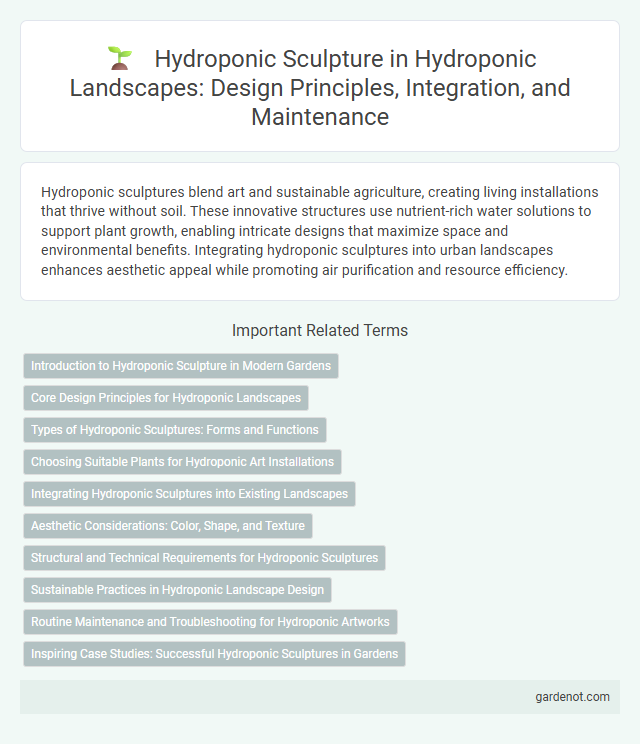Hydroponic sculptures blend art and sustainable agriculture, creating living installations that thrive without soil. These innovative structures use nutrient-rich water solutions to support plant growth, enabling intricate designs that maximize space and environmental benefits. Integrating hydroponic sculptures into urban landscapes enhances aesthetic appeal while promoting air purification and resource efficiency.
Introduction to Hydroponic Sculpture in Modern Gardens
Hydroponic sculpture transforms modern gardens by integrating soil-free plant cultivation with artistic design, creating living installations that thrive through nutrient-rich water solutions. These sculptures utilize advanced hydroponic systems to support diverse plant species, ensuring sustainability and vibrant growth without traditional soil requirements. As an innovative fusion of horticulture and art, hydroponic sculptures enhance garden aesthetics while promoting eco-friendly, low-maintenance greenery.
Core Design Principles for Hydroponic Landscapes
Hydroponic sculpture integrates living plants into artistic structures by prioritizing core design principles such as balanced nutrient delivery, optimal water circulation, and structural stability. Ensuring precise control of moisture levels and root aeration supports healthy plant growth within sculptural frameworks. Material selection and system maintenance are critical to sustaining vibrant, long-lasting hydroponic landscape installations.
Types of Hydroponic Sculptures: Forms and Functions
Hydroponic sculptures encompass a diverse range of forms including vertical gardens, living walls, and free-standing green structures designed to optimize space and enhance aesthetic appeal. These sculptures integrate various hydroponic systems such as nutrient film technique (NFT), aeroponics, and deep water culture (DWC) to support plant growth without soil. Functionality varies from air purification and temperature regulation to art installations, making hydroponic sculptures both practical and visually striking in urban and indoor environments.
Choosing Suitable Plants for Hydroponic Art Installations
Selecting plants for hydroponic sculpture requires prioritizing species with compact root systems and fast growth rates to thrive in soilless environments. Epiphytic orchids, bromeliads, and air plants are ideal due to their minimal substrate needs and aesthetic appeal. Incorporating low-maintenance herbs like mint and basil enhances both visual texture and air quality in hydroponic art installations.
Integrating Hydroponic Sculptures into Existing Landscapes
Integrating hydroponic sculptures into existing landscapes enhances environmental sustainability by reducing soil dependency and enabling precise nutrient delivery to plants. These sculptures provide dynamic vertical greenery, improving air quality and visual appeal in urban or limited-space settings. Advanced hydroponic systems within the sculptures support diverse plant species, promoting biodiversity and year-round growth without traditional soil constraints.
Aesthetic Considerations: Color, Shape, and Texture
Hydroponic sculptures integrate vibrant greens and diverse plant hues to create visually striking contrasts that enhance aesthetic appeal. The shapes vary from geometric to organic forms, offering dynamic visual interest and complementing architectural environments. Textural diversity is achieved through the selection of plants with different leaf sizes, surfaces, and growth patterns, contributing to a rich sensory experience in hydroponic landscapes.
Structural and Technical Requirements for Hydroponic Sculptures
Hydroponic sculptures require a robust frame made from corrosion-resistant materials such as stainless steel or UV-stabilized plastics to support plant weight and maintain stability. An integrated hydroponic system must include efficient water circulation pumps, nutrient delivery mechanisms, and aeration components to ensure optimal plant growth and prevent root rot. Precise control of environmental factors like light intensity, humidity, and temperature is essential for sustaining plant health within these three-dimensional living artworks.
Sustainable Practices in Hydroponic Landscape Design
Hydroponic sculptures utilize nutrient-rich water solutions to cultivate plants without soil, significantly reducing water consumption compared to traditional landscaping. These sustainable practices incorporate recycled materials and energy-efficient lighting systems, minimizing environmental impact while enhancing urban green spaces. Integrating hydroponic sculptures in landscape design promotes biodiversity and supports air purification in built environments.
Routine Maintenance and Troubleshooting for Hydroponic Artworks
Routine maintenance of hydroponic sculptures involves regular monitoring of nutrient solution levels, pH balance, and plant health to ensure optimal growth conditions. Troubleshooting common issues includes addressing clogged irrigation lines, nutrient deficiencies, and algae buildup by cleaning components and adjusting nutrient formulas promptly. Consistent upkeep enhances the longevity and aesthetic appeal of hydroponic artworks, preventing system failures and promoting vibrant plant development.
Inspiring Case Studies: Successful Hydroponic Sculptures in Gardens
Hydroponic sculptures, such as Patrick Blanc's vertical gardens, showcase innovative integration of plant life and art, transforming urban spaces into lush, living landscapes. These successful installations use nutrient-rich water systems to sustain vibrant greenery without soil, optimizing growth and aesthetic appeal. Their ability to enhance air quality and promote biodiversity demonstrates the potential of hydroponic landscape design in modern garden environments.
Hydroponic sculpture Infographic

 gardenot.com
gardenot.com